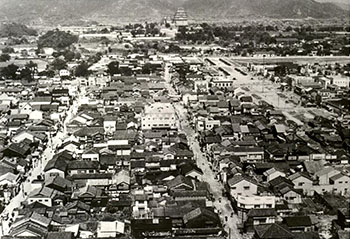
| Himeji Castle-related (major events) | Himeji Castle-related (other) / Events in the Himeji City area | Himeji Castle-related (other) / Events in the Himeji City area |
| Year (Western calendar) | Event |
| 8th century AD | Provincial capital of Harima established in Himeji. After the capital of Harima Province was established in Himeji, it gained and retained the status of a regional center where people and goods are gathered. It is thought that for this reason, when Hashiba (later known as Toyotomi) Hideyoshi and Ikeda Terumasa planned a new castle residence, it was a natural location to choose. |
| 1324-28 |
The Mineaiki chronicle tells of how rebellious forces in Harima Province gained increasing power, while construction methods were also progressing.
In the Mineaiki, a chronicle written during the Nanboku-cho period (Period of the Northern and Southern Courts, i.e. Kyoto and Nara, 1336-1392) tells of the emergence of new forces adept at castle-based military operations such as erecting yagura (turrets), casting stones, and building reconnaisance towers and various types of defensive mechanisms. |
| 1333 | According to accounts, Akamatsu Norimura (Enshin) joins the fight to topple the Ashikaga shogunate, and determines the layout of a castle on Mt. Hime. |
| 1346 | According to accounts, Akamatsu Sadanori builds a castle on Mt. Hime for the first time.
Akamatsu Sadanori worked with his father Akamatsu Norimura and the Akamatsu clan achieved domination of Harima Province. According to the Edo period (1603-1868) regional history Harima kagami, they relocated a temple on top of the mountain to its foot, and built the residence that was the first precursor of Himeji Castle. |
| 1397 | Kitayama-tei villa (Kinkaku, the Golden Pavilion) erected in Kyoto. |
| 1441 | Akamatsu Mitsusuke kills the shogun Ashikaga Yoshinori, but in the same year is defeated and killed at Kinoyama Castle. (Harima becomes part of the Yamana clan’s territory) |
| 1467 | The Onin War begins. According to accounts, Akamatsu Masanori regains control of Harima Province and restores the castle in Himeji.
The Akamatsu clan were removed from power in Harima in the Kakitsu War of 1441, but then Akamatsu Masanori took the opportunity presented by the Onin War of 1467 to regain control of Himeji, and according to accounts, restored various parts of it including the Tsurumimaru and Kameimaru compounds, the Sakura-mon and Kiri-mon Gates, and the Kikui Well. |
| 1469 | Akamatsu Masanori builds Ojio (Okishio) Castle and moves there. |
| 1535 | *A stone shaped like a five-storied pagoda engraved with this year was used as a reinforcement material for the wall of the old castle keep of Hideyoshi. |
| 1537 | The lower part of the Inuyama Castle tenshu (castle keep) is built. (The watchtower portion is added during the Keicho era [1596-1615]) |
| 1543 | A Portuguese ship runs aground on Tanegashima Island, and the first guns reach Japanese shores.
The guns brought by the Portuguese rapidly gained popularity around Japan, and had a major influence on military tactics and construction methods. Flatland castles surrounded by thick walls and turrets begin to take the place of the formerly prevalent mountain fortresses. |
| 1561 | Kuroda Shigetaka and his son Mototaka renovate Himeji Castle. (Eiroku-era new castle) |
| The Shomo-ji Temple Monjo Documents verify the existence of a Himeji military encampment.
According to a deed of land sale in the Shomyo-ji Temple Monjo documents, a field belonging to Suketayu in the village of Himeji is “at the west gate of the Himeji military encampment.” The details of this encampment are not known, but it may have later been incorporated as an element of Himeji Castle. |
|
| 1575 | The Battle of Nagashino: Kuroda Yoshitaka goes to Tokyo and meets Oda Nobunaga. |
| 1576 | Oda Nobunaga constructs Azuchi Castle and moves his headquarters there.
Oda Nobunaga’s Azuchi Castle established the mountain castle style: a magnificent tenshu (castle keep) in the center, high stone walls defending key strategic points on the mountain, and an air of might that overwhelmed the surroundings. Historical investigation of this site, primarily consisting of excavations, continues to this day. |
| 1577 | Hashiba (later known as Toyotomi) Hideyoshi is dispatched to Harima as part of the strategy to conquer the Chugoku region (western Honshu) (against the Mori clan). |
| 1580 | Miki Castle (Bessho clan), Aga Castle (Miki clan), and Chosuisan Castle (Uno clan) fall, Nobunaga establishes rule over Harima |
| Order given to demolish castles in eastern and central Harima (nine castles including Ojio (Okishio) and Gochaku).
In line with Hideyoshi’s plan to rule Harima, the Akamatsu clan’s Ojio (Okishio) Castle, one of the greatest medieval castles, and other castles considered unnecessary were destroyed, and castles were managed and governed from the top down according to a new framework of regional control. |
|
| Kuroda Yoshitaka offered up Himeji Castle to Hashiba (Toyotomi) Hideyoshi and moved to Koyama Castle in Mega. | |
| 1581 | Hashiba (Toyotomi) Hideyoshi builds a three-storied tenshu (keep) at Himeji Castle. |
| 1582 | Hashiba (Toyotomi) Hideyoshi floods Bicchu-Takamatsu Castle. Incident at Honno-ji Temple. Hideyoshi launches attack against Akechi Mitsuhide. |
| 1583 | Hashiba (Toyotomi) Hideyoshi builds Osaka Castle, and Hashiba Hidenaga becomes lord of Himeji Castle.
At the former site of Ishiyama Hongan-ji Temple, the castle was constructed as a Toyotomi family residence, and efforts also focused on the planning a development of the castle town, especially around Senba. Japan was in a transitional phase from the constant war of the Sengoku period to the peaceful unified nation of the Edo period, and a style of castle suited to the times was sought. |
| 1585 | Hashiba Hideyoshi is promoted to Juichii (Junior First Rank) and becomes a Kanpaku (lord). (He is given the surname Toyotomi the following year) |
| Akamatsu Norifusa is transferred to Awa Province. (The family that served as medieval military governors of Harima are moved to other provinces) | |
| 1588 | Nationwide edict to confiscate swords |
| 1590 | Toyotomi Hideyoshi defeats the Hojo clan in Kanto. Tokugawa Ieyasu becomes lord of Edo Castle. |
| 1591 | Toyotomi Hideyoshi dispatches an army to the Korean Peninsula. |
| 1598 | Deaths of Toyotomi Hideyoshi and Akamatsu Norifusa. |
| 1600 | The Battle of Sekigahara. Ikeda Terumasa is made ruler of Harima Province with more than 520,000 koku (one koku = approx. 280 liters or 150 kg. of rice, a unit measuring the estimated production volume of the domain) |
| 1601 | Ikeda Terumasa begins construction of Himeji Castle.
After the Battle of Sekigahara, Ikeda Terumasa, who became lord of a 520,000-koku domain in Harima Province and built the Himeji Castle we see today, was the son-in-law of Tokugawa Ieyasu, but he was also a tozama daimyo who received favors from the Toyotomi clan, and his selection as ruler was thought to be a placating gesture toward the Osaka side (Toyotomi Hideyori). |
| 1603 | Tokugawa Ieyasu unifies Japan as Seii Tai-Shogun (lit. “great general who subdues the barbarians.”) Princess Sen-hime becomes bride of Toyotomi Hideyori. |
| Ikeda Terumasa’s second son Tadatsugu is given a domain of more than 280,000 koku in Bizen Province. | |
| 1606 | Ikeda Terumasa engages in reconstruction work on Edo Castle. |
| 1607 | Ikeda Terumasa engages in reconstruction work on Sunpu Castle. |
| 1608 | Ikeda Terumasa engages in construction work on Tamba Sasayama Castle. |
| 1609 | Himeji Castle's Dai-Tenshu (main keep) is completed. |
| 1610 | Ikeda Terumasa’s third son Tadakatsu is given a domain of more than 60,000 koku in Awaji Province. |
| Ikeda Terumasa engages in construction work on Nagoya Castle. | |
| 1611 | Toyotomi Hideyori goes to Kyoto and meets with Tokugawa Ieyasu at Nijo Castle. (Terumasa accompanies Hideyori) |
| 1613 | Ikeda Terumasa dies. His eldest son Toshitaka succeeds a domain of 420,000 koku and becomes lord of Himeji Castle. |
| 1614 | Osaka Fuyu no Jin (Winter Siege of Osaka)
The reinforced Osaka Castle was impregnable, and the winter siege was a battle that fully demonstrated its capability as a military facility. However, after a truce was reached, the lines of defense were destroyed and there was no more holing up at Osaka Castle. |
| 1615 | Osaka Natsu no Jin (Summer Siege of Osaka). Ikkoku Ichijo Rei (Law of One Castle per Province) is issued.
After defeating the Toyotomi clan at Osaka Castle and establishing hegemony, Tokugawa issues an order restricting the number of castles in each province to one, where the lord resides, and after this the post-medieval castle system managed by the Edo-based Shogunate is put in place. |
| The Shogunate defines Buke shohatto (Laws for the Military Houses). (Construction of new castles is prohibited and repairs and improvements must be authorized) | |
| 1616 | Senhime re-married to Tadatoki, son of the lord of Kuwana Castle, Honda Tadamasa.
Tokugawa Hidetada’s daughter (whose mother was Ogo) married Toyotomi Hideyori, but he died during the Siege of Osaka, and she remarried and began a new life at Himeji Castle with Honda Tadatoki. At this time, the Nishi no Maru (west compound) was improved for their residence. |
| 1617 | Honda Tadamasa becomes lord of Himeji Castle. Tadatoki and Princess Senhime also reside at the castle. |
| 1618 | Honda Tadamasa modifies the Senba River and opens it to ship transport. Lumber towns develop along the Senba-gawa River. |
| 1619 | The shogunate strips Fukushima Masanori of his domain and position due to the unauthorized repair of Hiroshima Castle. |
| Ogasawara Tadasane moves from Matsumoto Castle and construction work on Akashi Castle starts. | |
| 1623 | Senhime enshrines a wooden statue of the deity Tenmandaijizai-tenjin at Mt. Otoko-yama. She worships it from far away in the Nishi no maru (west compound) |
| 1626 | Honda Tadamasa reinforces the first floor of the Himeji Castle Dai-Tenshu (main keep) with hozue, slender rods used to strengthen the extensions of the horizontal top rails. |
| Honda Tadatoki dies and Princess Sen-hime returns to Edo. | |
| 1637 | Shimabara Rebellion.
The Tokugawa Shogunate, having barely defeated the rebellious forces entrenched at Hara Castle, were wary of old castles being used for battle against it, and more strictly enforced the destruction of castles. After the Shimabara Rebellion there was no more full-fledged military conflict, and the number of people with actual battlefield experience gradually dwindled. |
| 1644 | The Shogunate orders each province to create and submit pictorial maps of the provinces and their castles.
The Shogunate in Edo had all daimyo nationwide submit pictorial maps of castles as well as creating maps of their domains. Shoho-kuniezu (Shoho domain maps), which exist to this day, gave a grasp of key military information on the castle with common nationwide specifications for elements such as kuruwa (compounds), moat size, tenshu (castle keep), and turrets that appeared in the illustrations. |
| 1648 | Asano Naganao becomes lord of Ako, begins upgrading the castle based on military theory. |
| 1652 | Sakakibara Tadatsugu inspects salt inside Himeji Castle, dedicates an ishi torii (stone torii gate)at the main shrine (still extant today).
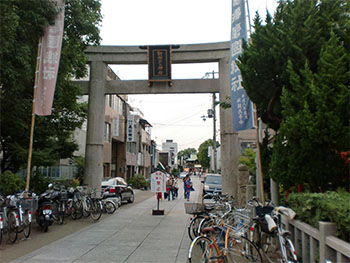 Ishi torii at the main shrine Ishi torii at the main shrine |
| 1656 | Sakakibara Tadatsugu repairs bases of large eastern and western columns in Himeji Castle Dai-Tenshu (main keep).
The Himeji Castle Tenshu (keep) has two large columns going through its center and solidifying the internal structure of the multi-story building. According to accounts, 50 years after it was first built, major repairs were performed to reinforce the foundations of the large columns. 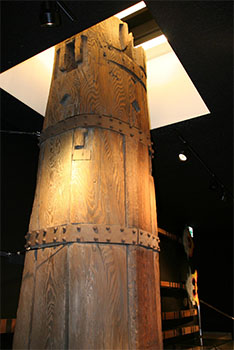
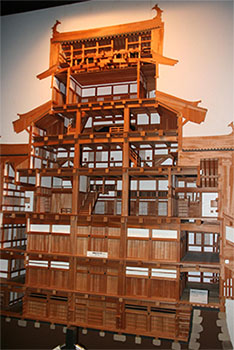 Left: Himeji Castle Dai-Tenshu eastern pillar (base) |
| 1657 | Edo Castle Tenshu (keep) destroyed by the Great Fire of the Meireki era (never rebuilt)
As Japan's largest tenshu, it demonstrated the might of the Tokugawa Shogunate. Afterward Edo Castle had no keep for a long time. This served as an opportunity to reconsider the relationship between castles and their keeps. 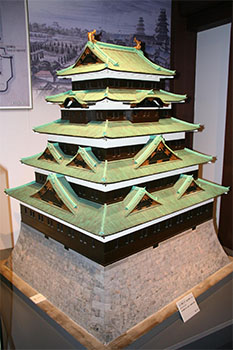 Edo Castle Tenshu model Edo Castle Tenshu modelHyogo Prefectural Museum of History: Castle Gallery |
| 1659 | Himeji Castle town / At the Honmachi home of Tajima Kyuzaemon, former samurai Seijuro attacks and injures people with a sword. (Onatsu / Seijuro) |
| 1687 | Honda Tadakuni adds supports to the Himeji Castle Dai-tenshu (main keep) and also repairs the roof. |
| 1701 | The Asano clan of Ako are stripped of their property and position. Honda Tadakuni donates land and builds Kabutoyama-jinja Shrine. |
| 1741 | Sakakibara Masamine pays off the debts of the Edo Yoshiwara courtesan Takao and is punished. |
| 1743 | Matsudaira Akinori installs braces and struts in the Himeji Castle Dai-tenshu, stopping its tilt. |
| 1749 | Sakai Tadazumi becomes lord of Himeji Castle. His karo (chief retainer) responds swiftly to flood damage in the castle town.
An anecdote relates that people were evacuated to Himeji Castle during the flood. A monument mourning people that drowned (still extant today) was erected on the mountainside on the left bank of the Ichi-kawa River. 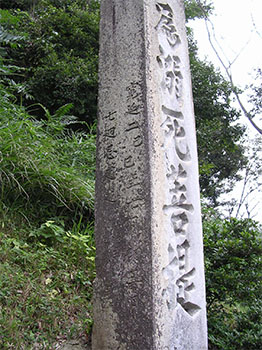 ![Buddhist monument to same tragedy / Left: number of victims]](obj/img/img_ad1749-2-sp.jpg) Left: Monument to victims of the flood of 1749 |
| Kokodo, a han (domain) school for children of the ruling class, opens next to the gate of the main shrine. Keifuku-ji Temple moved to present location. | |
| 1762 | Nengu (land taxes) revised for Hashimoto Shin-machi and Kosho-machi in the Himeji Castle town, and chishigin (another type of land taxes) levied. |
| 1773 | Sakai Tadazane nails handrail to the corners of the outer moat to prevent falling in. |
| 1799 | Sakai Tadamichi celebrates 50 years of the Sakai clan in Himeji at Himeji Castle. |
| 1809 | In response to a law levying rice, etc. from common people for to prevent famine, Sakai Tadamichi builds food reserve storehouse called Konei-so in his domain.
Grain storage facilities as a countermeasure against famine are built in the Himeji domain. The name of the storehouse is derived from the Chinese Shang Shu (Book of Documents), which states, “The people are the foundation of the country, and if the foundation is solid, the country will be peaceful.” 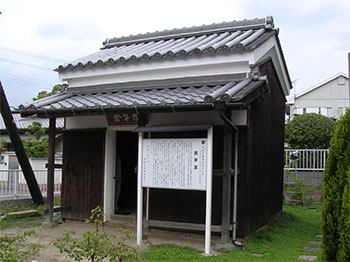 Konei-so in Nozato Konei-so in Nozato |
| 1816 | Kokodo, a han (domain) school for children of the ruling class, moved to the dismounting area in front of the castle and expanded. |
| 1820 | Himeji Domain rulers move a Higashiyama ware pottery kiln to foothills of Mt. Otoko-yama Mountain. |
| 1822 | Horses from the southern part of Mutsu Province are released to graze in the se-gakushi (space for hiding military forces) at Himeji Castle (to be prepared for transporting emergency supplies)
A kuruwa (compound) stretches along the northern feet of Mt. Hime and Mt. Sagi, where Himeji Castle is located, on the other side of the inner moat. This is a spare space for concealing troops, but it was used for various purposes. 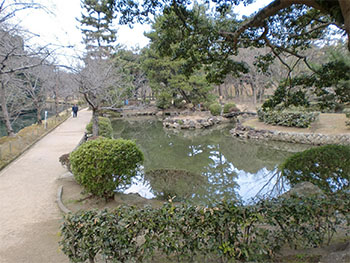 Himeji Castle se-gakushi Himeji Castle se-gakushi |
| 1846 | Sakai Tadatomi begins building Shikama Harbor. |
| 1849 | The Shogunate permits the Matsumae Domain (Ezo) and Fukue Domain (Goto-retto Islands) to build new castles. |
| 1850 | Himeji Domain builds artillery batteries in Ieshima Island and Murotsu. |
| 1853 | US Commodore Perry leads four kurofune (black ships) to Uraga. |
| 1857 | Construction of Goryokaku Fortress begins in Hokkaido. |
| 1865 | Tadashige Sakai appointed Tairo (chief minister) of the Shogunate. |
| 1868 | After the battles of Toba and Fushimi, Okayama Domain troops stay in Himeji and confront the forces there. Himeji Castle opened on January 16th. |
| 1871 | Haihan chiken (feudal domain system abolished and prefectural system was introduced.) The 16 gun (counties) of Harima Province become Himeji Prefecture (later renamed Shikama Prefecture). |
| 1873 | Castles nationwide are divided between the jurisdiction of the Ministry of the Army (58 castles including Himeji Castle) and of the Ministry of Finance.
Castles under the jurisdiction of the Ministry of the Army are allowed to survive in physical form, while others are classified as “abolished castles,” their buildings deemed unnecessary and removed. Maintenance of aging structures was difficult, and many could not be saved. |
| 1874 | It is decided that the 10th infantry regiment of the Osaka Garrison will be stationed in Himeji, and one unit is dispatched. |
| 1876 | Shikama Prefectural Office transferred from the former castle (Sannomaru, third compound) to Mt. Yakushi outside the castle.
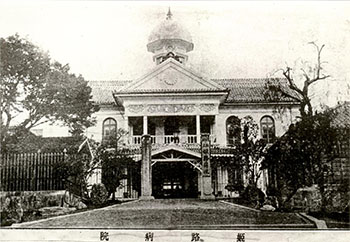 Shikama Prefectural Office Shikama Prefectural OfficeLater converted to Himeji Hospital *Hyogo Prefectural Museum of History Collection (Hidekichi Takahashi Collection) |
| Shikama Prefecture abolished and absorbed into Hyogo Prefecture. | |
| 1877 | In the Seinan War, the Saigo forces besiege and attack Kumamoto Castle but it does not fall. |
| 1878 | Colonel Shigeto Nakamura applies for preservation of Himeji Castle, Nagoya Castle.
Thanks to the work of Colonel Nakamura, who applied to Army Minister Aritomo Yamagata for repair funds for Nagoya Castle and Himeji Castle as structures unparalleled in Japan, funds were allocated for their upkeep. |
| 1882 | Bizenmaru compound buildings at Himeji Castle burn in a fire. |
| 1889 | Himeji becomes an official city. |
| 1894 | Bantan Railway (between Himeji and Teramae Stations) begins operating. |
| 1896 | 10th Infantry Regiment of the Imperial Japanese Army is established in Himeji. (Military facilities are concentrated inside the former second moat)
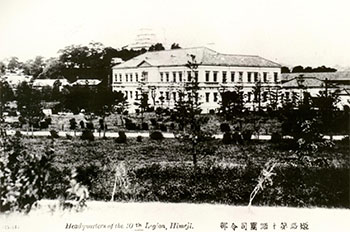 Headquarters of 10th Infantry Regiment of the Imperial Japanese Army Headquarters of 10th Infantry Regiment of the Imperial Japanese Army*Hyogo Prefectural Museum of History Collection (Hidekichi Takahashi Collection) |
| 1904 | Russo-Japanese War begins. |
| 1908 | Shirosagi (“white heron”) Castle (another name for Himeji Castle) Preservation Society formed, contractors hired for maintenance and repair of the castle. |
| 1910 | Himeji Castle Meiji-era renovations carried out (completed the following year).
A temporary pier for construction extends from the east side of the scaffolding-covered tenshu to the front of the Kisai-Mon Gate. With this full-scale renovation, Himeji Castle was finally equipped to escape deterioration due to aging. 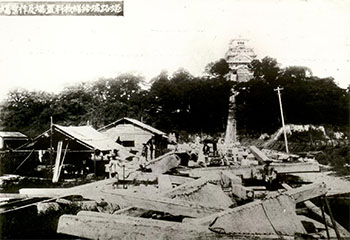 Himeji Castle Meiji-era renovations Himeji Castle Meiji-era renovations*Hyogo Prefectural Museum of History Collection (Hidekichi Takahashi Collection) |
| 1912 | Himeji Castle (inside Honmaru and Ninomaru, main and second compounds) granted to Himeji City and opened to the public as Himeyama Park. |
| 1919 | Toyotomi Hideyoshi bronze statue (pedestal extant) installed in the se-kakushi on the castle grounds.
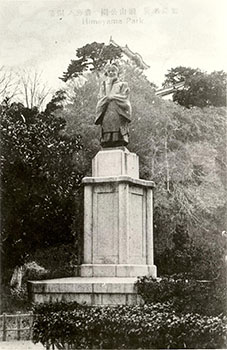 Bronze statue of Toyotomi Hideyoshi Bronze statue of Toyotomi Hideyoshi*Hyogo Prefectural Museum of History Collection (Hidekichi Takahashi Collection) |
| 1925 | 10th Infantry Regiment relocated to Okayama, Himeji Castle Scenic View Conservation Association formed to preserve its former site. |
| 1928 | Himeji Castle's land of more than 200,000 square meters is designated as a historic site under the Historical Spot, Scenic Beauty and Natural Monument Preservation Law. |
| Jurisdiction over Himeji Castle is transferred to the Ministry of Education. | |
| 1931 | Nine tenshu (castle keep) structures at Himeji Castle are designated as National Treasures under the Law for the Preservation of National Treasures. (Turrets, gates, and walls added to designation that same year) |
| The Tenshu (keep) of Osaka Castle is rebuilt with reinforced concrete. | |
| 1932 | For the upgrading of National Route 2, the second moat is filled in from the Uzumi-Mon Gate to the Sosha-Mon Gate.
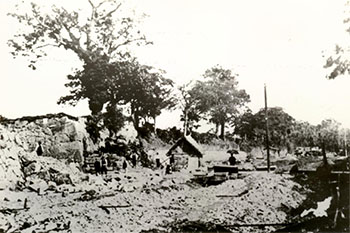 Second moat being filled in Second moat being filled in*Hyogo Prefectural Museum of History Collection (Hidekichi Takahashi Collection) |
| Area of Himeji Castle open to the public is expanded to everything inside the Hishino-Mon Gate, including the Nishi no Maru (west compound) | |
| 1934 | Ceremony and festival held in Sannomaru (third compound) to mark 600th anniversary ceremony of castle’s construction. |
| Due to heavy rain, Nishi no Maru nagatsubone and stone walls partially collapse, and repairs under the direct management of the Ministry of Education begin. | |
| 1937 | During a Shochiku Cinema shoot, part of the Ro no Mon (Ro Gate) and earthen walls are accidentally blown up. |
| Pine bark beetles infest pines at Himeji Castle, causing damage. (Pine saplings planted) | |
| 1941 | Five layers of camouflage netting placed over the Himeji Castle Dai-Tenshu (main keep) as a trial (entire Tenshu covered the following year).
Straw rope about 6 mm thick was dyed with ink to make a camouflage net with a mesh of about 3 cm, hiding the white walls of Himeji Castle to prevent targeting in air raids. 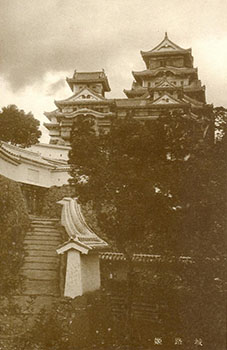 Himeji Castle Tenshu (keep) covered with a camouflage net Himeji Castle Tenshu (keep) covered with a camouflage net*Hyogo Prefectural Museum of History Collection (Hidekichi Takahashi Collection) |
| 1943 | Himeji Castle Nishi no Maru (west compound) turrets and Ha, Ni gates’ roof joint plaster painted an antique color. |
| Air raid shelter dug on Himeji Castle grounds. | |
| 1944 | Reservoir for firefighting dug on Himeji Castle grounds. Monument honoring Colonel Shigeto Nakamura erected (extant). |
| 1945 | In an air raid on July 3, 1945, Himeji City was decimated, but Himeji Castle (within the Hishino-Mon Gate) was not damaged.
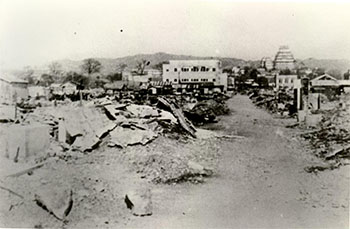 City reduced to rubble, Himeji Castle unharmed City reduced to rubble, Himeji Castle unharmed*Hyogo Prefectural Museum of History Collection (Hidekichi Takahashi Collection) |
| Air raid evacuees gathered in the Nishi no Maru (west compound). | |
| World War II ends. Camouflage net removed from Himeji Castle. | |
| 1947 | Baseball field and sumo arena opened in Himeji Castle Sannomaru (third compound).
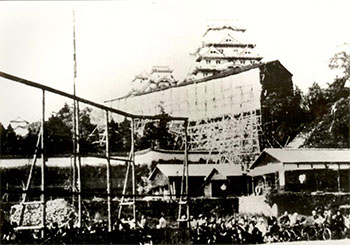 Himeji Castle / Sannomaru baseball field Himeji Castle / Sannomaru baseball field*Hyogo Prefectural Museum of History Collection (Hidekichi Takahashi Collection) |
| 1949 | Shirosagi (“white heron”) Castle (another name for Himeji Castle) Preservation Society reformed, applies for financial assistance from national government. |
| 1950 | Suspended work on Himeji Castle preservation restarted. Electric lamps are installed in Himeyama Park. |
| 1951 | Tenshu (keep) of Himeji Castle newly designated a National Treasure under the Cultural Properties Protection Act. |
| 1955 | Otemae Street connecting Himeji Castle and Himeji Station is completed.
|
| 1956 | Work begins in earnest on dismantling and repairing the Himeji Castle Dai-tenshu (main keep), etc.
A temporary pier for construction was installed, extending from the south side of the scaffolding-covered Tenshu (keep) to the Sannomaru (third compound). In these large-scale repairs, the entire Tenshu was dismantled, and after a ground survey and the construction of a concrete foundation, was reassembled with new materials added. 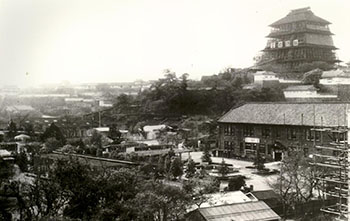 Himeji Castle dismantling and repair work / 1955 - 1964 Himeji Castle dismantling and repair work / 1955 - 1964*Hyogo Prefectural Museum of History Collection (Hidekichi Takahashi Collection) |
| Himeji Castle site designated a Special Historic Site. | |
| 1959 | Himeji Castle Dai-tenshu tatebashira-shiki (ceremony performed when main column is erected). |
Cypress from Kiso Valley and Mt. Kasagata brought in for new large western column.
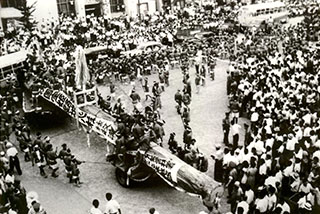
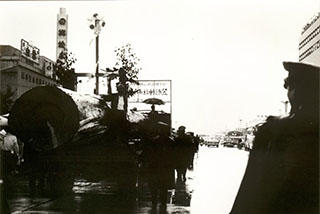 *Both Hyogo Prefectural Museum of History Collection (Hidekichi Takahashi Collection) Left: Himeji Castle Dai-Tenshu large western column delivered / Kiso cypress |
|
| 1960 | Himeji Castle Dai-tenshu wood construction finished, festival held to celebrate. |
| 1964 | End of conservation work on Himeji Castle Tenshu group and surrounding buildings. |
| 1972 | Sanyo Shinkansen (Shin-Osaka - Okayama) begins operating. |
| 1976 | Full-scale excavation of buried cultural assets around Himeji Castle site begins. |
| 1983 | Hyogo Prefectural Museum of History and Himeji City Museum of Art open on the Himeji Castle grounds. |
| 1989 | ’89 Himeji Shirotopia exhibition held at Himeji Castle site to celebrate centennial of Himeji City’s establishment. |
| 1993 | Himeji Castle and Horyu-ji Temple in Nara are named Japan’s first World Heritage Sites .
The series of connected tenshu (castle keeps) and many existing gates (15), walls (32), and turrets (27 buildings) have been designated as National Cultural Properties, and the area inside the former second moat is designated as a Special Historic Site. This is truly a castle that represents both the strength and the aesthetic refinement of Japan. |

